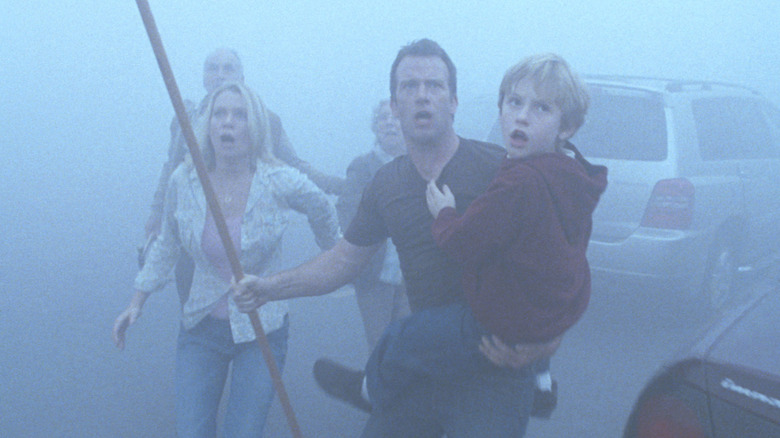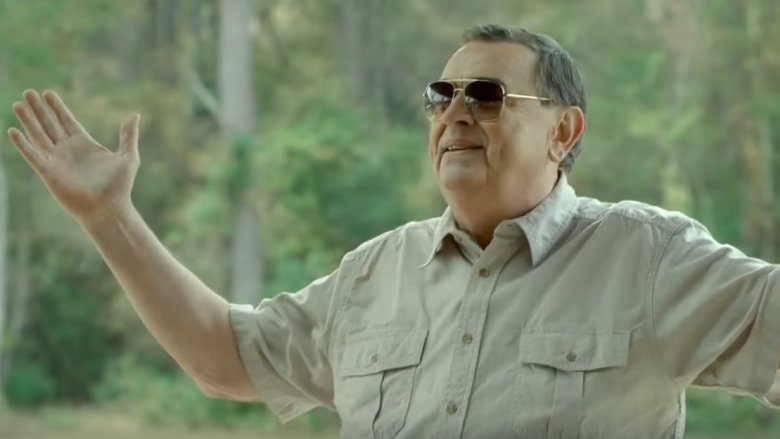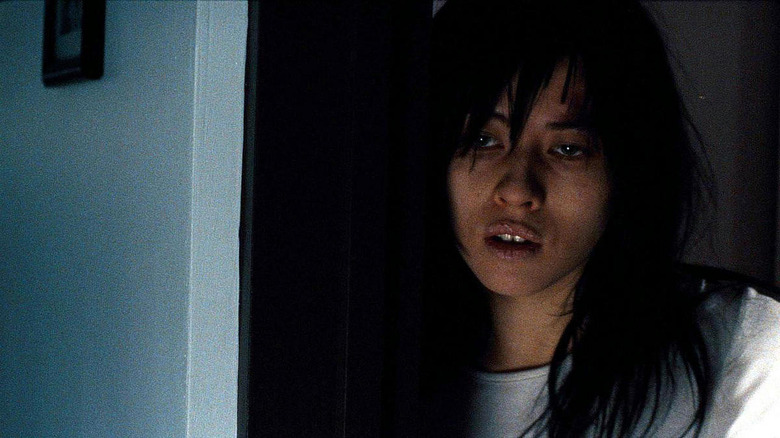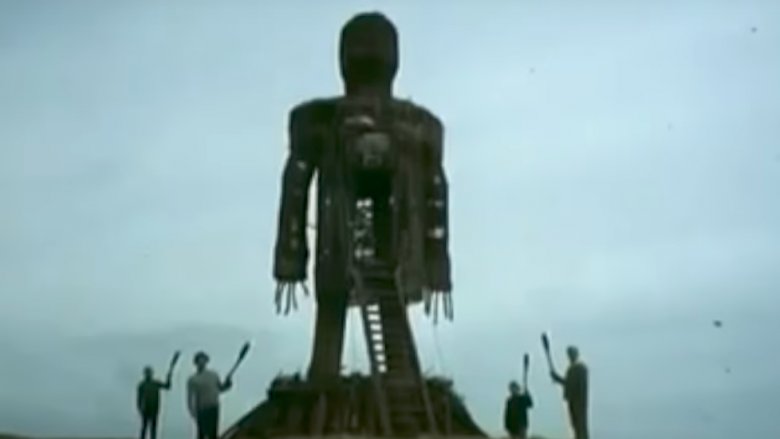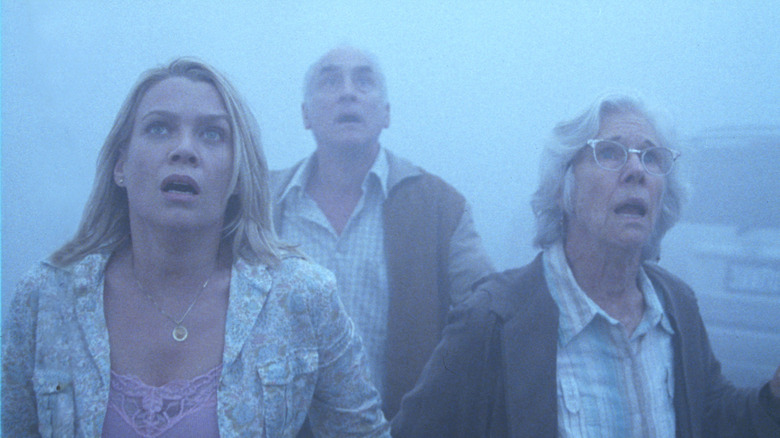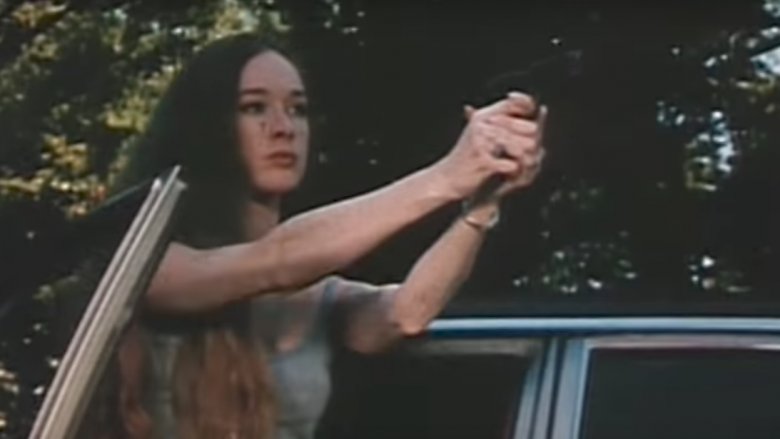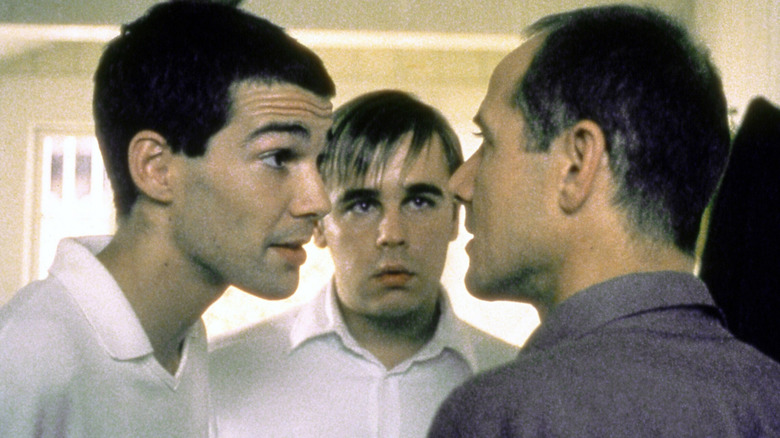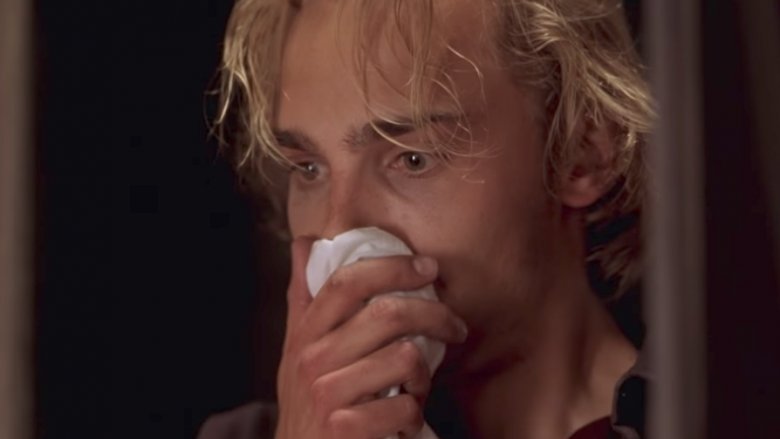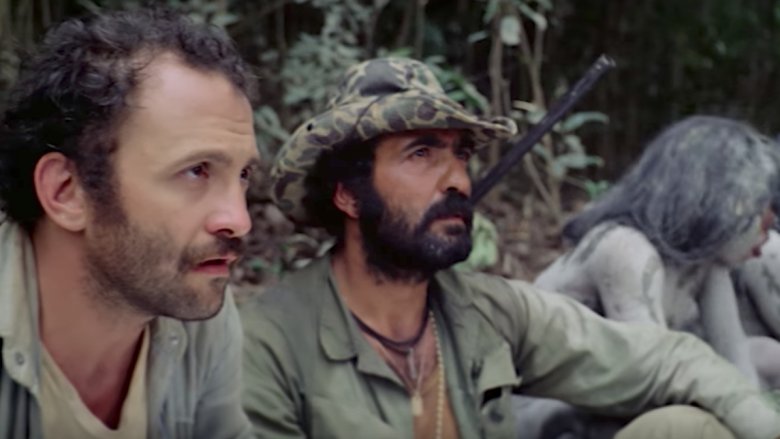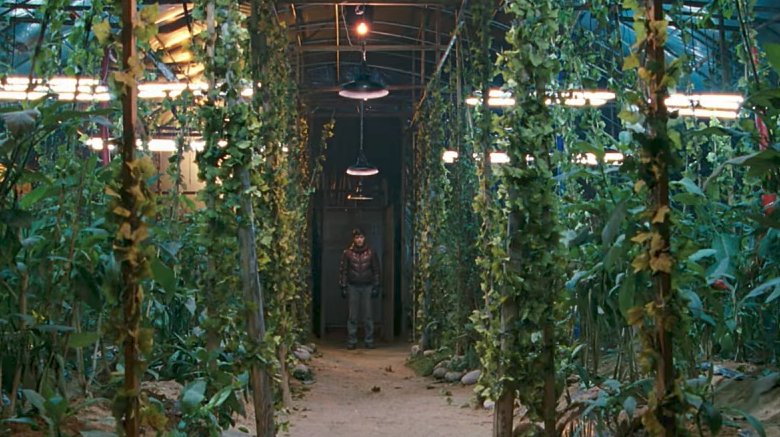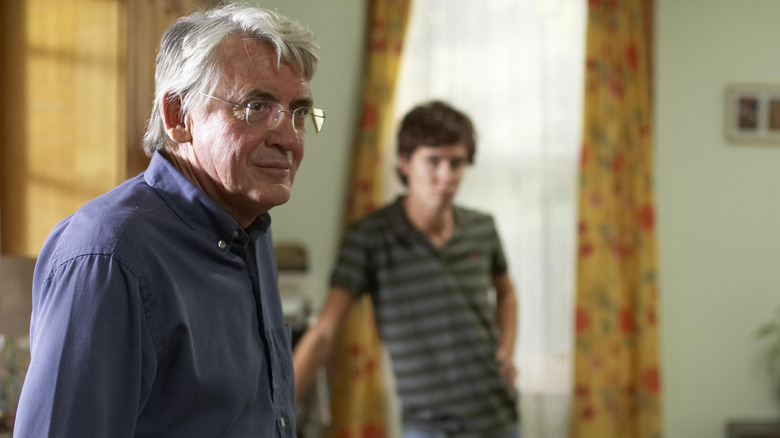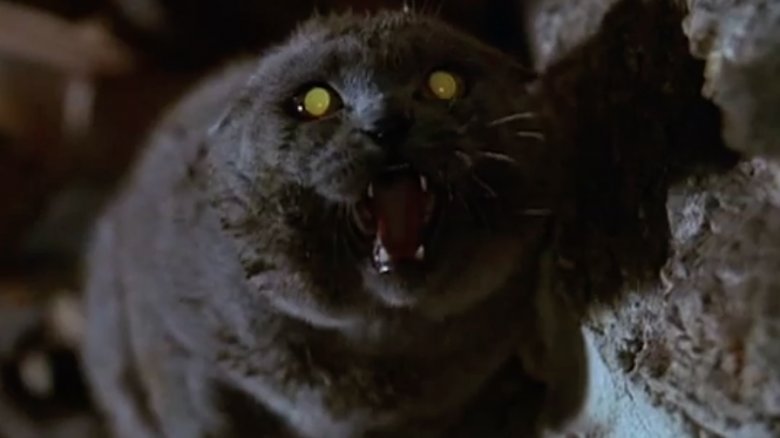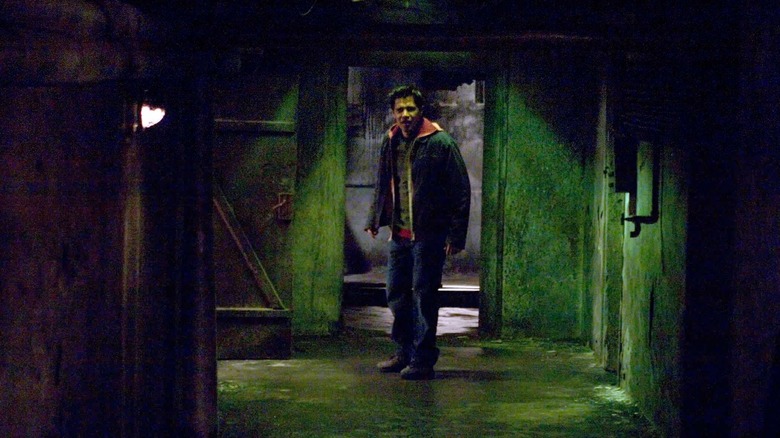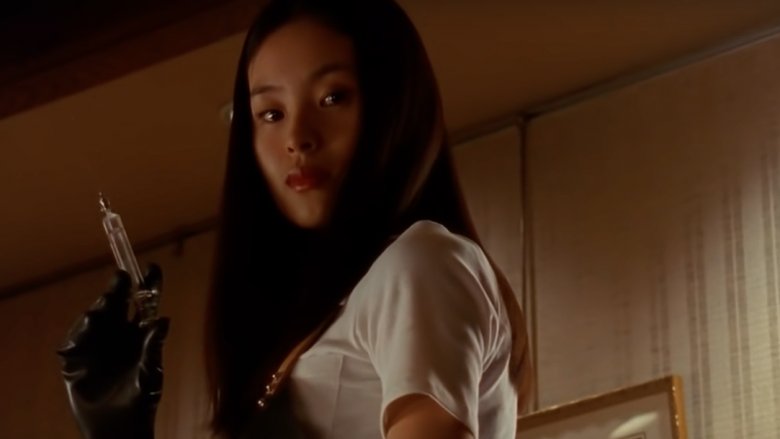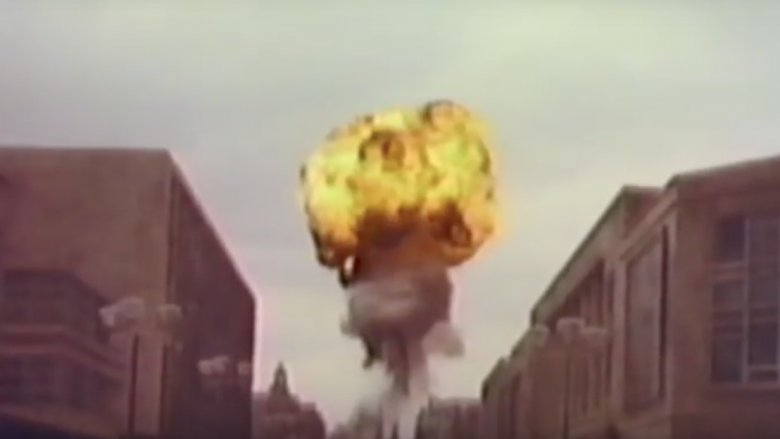The Hardest Horror Movies To Watch More Than Once
For all of the terror they instill in us, horror movies are generally a lot of fun to watch. They wouldn't have the longevity they do on an individual basis, much less that of the genre, if they weren't. Nonetheless, for every horror flick that gets picked up for annual rewatches and movie nights with friends, there's another that isn't quite as easy to watch a second, third, or fourth time.
Some of these movies are tough to go back to because they depict violence too extreme for most viewers. Others go to emotional extremes that aren't nearly as fun to revisit as others. And some are totally fine up until a particularly horrifying ending (consider this your spoiler alert). Whether due to excessive gore or devastating endings, some horror films are really only meant to watch once; with that in mind, we've put together a grim and grisly list of entries in the genre that aren't nearly as easy to revisit after the end credits roll.
The Sacrament (2014)
Director Ti West made his name with immaculately-crafted slow-burn horror films like The House of the Devil and The Innkeepers. They're plenty scary but ultimately a whole lot of fun. But West changed things up with 2014's The Sacrament, a faux documentary about three reporters investigating a new religious movement that recently moved itself to a secluded community in Africa.
Loosely based on true events, the film is excruciatingly tense and takes the story and its characters to some incredibly dark places. The film's climax depicts the ritual life-taking of the cult members, and West does not flinch from a single moment of the pain, confusion, and fear they experience. It gets particularly difficult to watch when one of the reporters is tied down by his sister, a member of the cult, and forced to participate in the mass death with her.
In terms of craft, The Sacrament is probably the best film by an already masterful horror filmmaker. But once you've watched the film and know the places it will take you to, it's almost impossible to revisit.
Martyrs (2008)
The exceedingly gruesome modern genre that has come to be known as "torture p***" got its unofficial start with 2004's Saw, but it hit its artistic apex (or nadir, depending on who you ask) with 2008's Martyrs. It's a difficult film to watch on content alone, with characters experiencing every kind of torture imaginable, from being beaten to being flayed alive.
But it's the intent behind that torture and the overall thematic arc of the film—the search for forbidden knowledge and what finally possessing that knowledge can do to the human mind—that truly makes Martyrs a difficult film to get through. It builds to a hopeless ending implying that what waits for humans after death is either too horrible to know or nonexistent, simply a void. It's an experience, and one genre fans should absolutely partake in, but it is an exhausting one.
Megan is Missing (2011)
The claim that a horror film is "based on true events" is usually tacked on to movies about haunted houses or possessions, often with the intention of stoking the interest of a potential audience. But that it's a claim Megan is Missing can make is a major component in making it a movie impossible to stomach more than once.
The film, structured around fictionalized found footage, tells the story of the disappearance of two 14-year-old girls and, in its last 20 minutes, shows the audience what has happened to them. It's among the most stomach-churning final acts in modern cinema and will almost certainly leave a bad taste in a viewer's mouth. The knowledge that what has just been seen is to some degree based in reality just worsens that feeling. Exorcisms and ghouls are scary, but Megan is Missing shows us horrors that are all too real.
The Wicker Man (1973)
Not to undersell how effective a good old fashioned masked murderer can be, but there are few things in the realm of horror more terrifying than a film that effectively examines the monstrosities that human beings are capable of when indoctrinated under a system of belief. No film has ever done this as effectively as the grandfather of the slow-burn horror film, The Wicker Man.
It's the rare genre entry that contains not a single fakeout jump-scare, or even a non-deceptive one for that matter. For the majority of its running time it's a tense but quiet thriller that builds slowly but surely to an inevitable and horrifying climax. And it's not until after that climax has played out and the credits are rolling that fear grips the viewer and doesn't let go for quite some time. It's an ending that recontextualizes everything that came before it, and while that's usually the sort of ending that merits a rewatch, it's not the case with The Wicker Man. It's far more likely to leave viewers too unsettled by what they've just seen to revisit it.
The Mist (2007)
Sometimes all it takes is an especially dark ending to make a film impossible to revisit, and one could easily make the case that The Mist has the bleakest ending in film history. Up until its climax, The Mist is grim, sure. But the first two acts of the film don't even begin to reach the depths of brutal hopelessness the ending does.
Stuck in a car that has run out of gas and stranded in the middle of the monster-ridden mist that had him and his son trapped in a grocery store for most of the film, Thomas Jane's David carries out mercy killings at the request of the survivors with whom he's escaped—the last of which is carried out on his young son, Billy.
Upon realizing he's out of bullets and cannot take his own life, he stumbles into the mist waiting to be killed by the monsters, only to be greeted with the arrival of the US Army. He and his son were moments from being saved. It's impossible to overstate how devastating it is to watch play out, and as well-crafted as the film may be, it effectively ruins any possible desire viewers may have to rewatch it.
I Spit On Your Grave (1978)
While films based around revenge almost necessitate the depiction of some horrid, inhumane act, few are quite as repulsive as that which is depicted in I Spit on Your Grave. The film is the story of a woman out for blood after being raped and left for dead in the woods by a group of men. Make no mistake, the men get what they deserve. Each dies bloodier than the last as she makes her way down her list. But in order to get to that point in the movie, the viewer has to sit through an excruciatingly long scene depicting the very realistic sexual assault of a woman.
Sexual assault is subject matter that will never be comfortable to sit through in any film, but it's depicted so brutally in I Spit on Your Grave that it borders on unnecessary. Even die-hard fans of exploitation film will likely find themselves uncomfortable with the idea of sitting through this one a second time. It's a hallmark of the genre for the same reasons it's near impossible to watch more than once.
Funny Games (1997)
Sometimes bad things happen to good people and there's no rhyme or reason to it. Funny Games is a story about this very idea. Two sociopathic youths, Peter and Paul, stage a physical and emotional assault on a family in their own home. Bones are broken. Lives are ended. A dog gets killed. All of this is done in service of a sick game being played by the boys.
There is no backstory between the family and the men torturing them. It's not a revenge scheme, and there is no plot twist revealing the boys to be the abandoned children of the mother or the father. Peter and Paul simply show up, commit countless atrocities, and then move on to the next family. Funny Games is a horrifying film. Tremendously made, yes, but horrifying. Between the horrors depicted onscreen, the joy Peter and Paul take in them, and the senselessness of the whole ordeal, it's not a movie you'll be anxious to revisit after your first time with it.
The Invitation (2016)
Even without its twist ending, Karyn Kusama's The Invitation would be uncomfortable to sit through a second time. The film sets out to put the nuance of interactions between lapsed friends under a microscope. Through a few hours spent at a tense dinner party it analyzes the minute intricacies of every awkward exchange between characters and explores the efforts people will go through to maintain face and stifle survival instincts when cordial social interactions go to places they shouldn't.
Furthermore, it's a stunningly poignant meditation on grief and what people will do to cope with loss. These themes are explored intricately and stunningly, but they're so heavy that a second viewing is likely out of the question for most moviegoers. And this is all before the film's third act, which features the host couple trying to murder their friends and then kill themselves in the name of a mysterious spiritual group they've joined. All in all, it's an immaculate film that is probably best left alone after a single viewing.
Cabin Fever (2002)
Body horror can be particularly unsettling when done well and gore-hound wonderchild Eli Roth's debut film Cabin Fever does it very, very well. A group of hot young twenty-somethings go to a secluded cabin in the woods for a vacation (stop us if you've heard this one before) and find themselves pursued by...nobody? No, rather than an axe-wielding murderer or an undead dream demon, they're infected with a flesh-eating virus.
Stranded in the middle of the forest with no access to medical aid, the disease slowly takes its hold, leaving open sores, rotting welts, and flesh falling from the bone. It's genuinely horrifying to watch, especially once you get to the film's infamous centerpiece: the scene in which a character is in a bathtub shaving her legs, skin peeling off as she does it. Even the least-squeamish of viewers will have a whole lot of trouble getting through Cabin Fever a second time—or a first, even.
Cannibal Holocaust (1980)
It likely won't come as a shock given the film's title, but Cannibal Holocaust is one of the most infamous movies of all time, regardless of genre. It may not have been the first film to trade entirely on the promise of violence and mutilation but it certainly did it better and more excessively than any film had at the time. It's a cornucopia of sexual assault, dismemberment, and animal violence (some of which is totally real).
There were even longstanding rumors that it depicted actual murder, resulting in the arrest of director Ruggero Deodato, though those allegations thankfully ended up being false. Connoisseurs of exploitation cinema are practically required to give Cannibal Holocaust a watch at some point. But it takes a moviegoer with a VERY high tolerance for gore and simulated depravity to make this a movie they revisit after the first time around.
I Saw the Devil (2010)
I Saw the Devil has all the makings of an infinitely rewatchable movie. The story and characters are compelling, the fight sequences among the best this side of John Wick, and lead actor Lee Byung-hun of Storm Shadow fame delivers a tour-de-force of a performance as Kim Soo-hyun, a man with a very particular skill set (sound familiar?) hunting down his wife's killer. As his hunt progresses, it becomes less and less clear if he's truly the hero of this story or just another villain.
The problem is that I Saw the Devil is also a movie about grief, nervous breakdowns, cannibalism (literal and metaphorical), and the depravity of man. It is a brutal, nihilistic film that should absolutely be seen, but likely cannot be seen again beyond that first viewing. There is no light in this movie, nor is there any hope. There's just the dark, horrifying path revenge drags a man down and the ruin it leaves in its wake.
Lake Mungo (2008)
There are points at which Lake Mungo hardly feels like a horror film. Rather, the imitation-documentary plays out as a look into how the death of a loved one can devastate the people around them over time. There are supernatural elements to the film and some great frights to be had, but they're comparatively sparse across the movie's hour and a half running time. Those scares aren't what will keep viewers from coming back for a second viewing, though. That falls entirely on the subject matter.
By staging the film as a fake documentary with no well-known actors to damage the audience's suspension of belief, director Joel Anderson amplifies the tangibility of the emotional devastation the Palmer family is experiencing after the death of their daughter Alice. That the supernatural aspects of the plot play directly into the emotions Anderson is exploring (the idea being that the ghost of Alice is simply trying to provide her family with the closure they're failing to find) only heightens this.
Lake Mungo is a tremendous film, but one that deals with some very heavy subject matter. One might not find themselves inclined to give it a second watch, due not so much to the scares it provides but the realism with which it depicts an extremely trying experience that many viewers may find themselves all too familiar with.
Pet Sematary (1989)
Pet Sematary has all the trappings of a fun, super-watchable Stephen King adaptation. It features such ever-present horror tropes as a family moving into a new home, a mysterious graveyard, and feverish visions of dead people. Were it not for a particular second-act plot point it could end up a seasonal Halloween viewing staple for some horror fans.
Unfortunately, well, there's that second act plot point, which features the death of the family's young son Gage in a car accident. It's a jarring moment, one that drastically alters the course of the movie from standard Halloween fare to a film taking on the heavy subject of what a parent will do to cope with that loss. In the case of Louis Creed, the answer is apparently "resurrect Gage via aforementioned mysterious graveyard with no regard for the fact that he'll be a terrifying zombie murder child upon his return."
There's probably a way the film could have handled this second act transition so as to make it less jarring, but in its current state it's a terribly depressing turn of events, one that will likely feel all too real for any viewer with children or young siblings. It effectively ruins Pet Sematary for multiple viewings, although it's still worth checking out that first time.
Hostel (2005)
While James Wan's Saw is often pointed to as the film that kickstarted torture-centric horror as a genre, Hostel is the movie responsible for stripping away any of its pretense and really making it what it is today. Director Eli Roth's plot revolves entirely around mutilation and dismemberment. Its story cuts directly to the chase when it comes to this, with the story centering around a secretive organization that provides clients possessing amply-sized wallets to torture kidnapped tourists in Europe.
While other genre staples like Saw and Martyrs seem to use torture as a means to explore, respectively, a genuinely intriguing plot or heavy thematic questions about human nature, Hostel makes no excuses for what it is. It's a movie about torture and pain, and Roth expects the audience to enjoy it. To be fair, there's a good chance they will. The film is a goldmine for gore fanatics and the practical effects utilized are top notch. But at the end of the day, it's a movie about people being physically ripped to shreds. In its defense, it depicts those horrors better than just about any other "torture p***" film. It was even successful enough to spawn not one but two sequels.
But unless you're the kind of viewer who specifically enjoys gore effects in horror, you might not find yourself wanting to watch Hostel more than once.
Audition (1999)
The notorious director Takashi Miike released his 100th feature film earlier this year, with yet another having just recently been released. He could go on to direct 100 more and it's likely that not a single one would accumulate the reputation that his 1999 film Audition has.
It's the story of a widower who, at the urging of his son, connects with a young woman named Asami. As their romance develops, it becomes clear that there is more to her than she has let on. Suspicions build slowly towards the film's bloody climax, which features a horrific scene of torture (you'll never look at a piano quite the same) and a mutilated man being sadistically kept alive by Asami in a bag. Other films featuring torture might try to shock the audience with a wide array of methods, but Miike instead pares it down to one excruciatingly simple, prolonged act: Asami severs the foot of her lover with a piano wire.
Audition is a masterpiece, of that there is no doubt. Miike's filmography is littered with crossover hits like Ichi the Killer and 13 Assassins, but Audition's reputation stands above them all, despite the fact that it may be more famous for the horrors presented in its final act (don't get us wrong, it is an exceptional film front to back). It is absolutely worth seeking out, but one should go in knowing that it is a hard movie to get through the first time around. And knowing what the end holds will not make rewatching it any easier.
Threads (1984)
There's a good chance you haven't heard of Threads, and that may be a good thing. The film aired as a TV movie in Britain in 1984, granting it a relatively smaller audience than something theatrically released. Nonetheless, it warrants a place on this list on the merit of being one of the more disturbing TV movies of all time. The film depicts the aftermath of a nuclear holocaust on a working-class community and the general long-term effects of nuclear war. The imagery is astonishingly graphic and grim, and the film's message isn't exactly the cheeriest. Nuclear war is a far more direct and real horror than zombies or vampires, and the film isn't subtle in its parable. That the film is done in the style of a documentary only adds to its gritty, horrific realism. Even with the era in which the film was made now having long since passed, Threads is a rough, rough watch.
